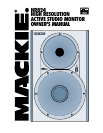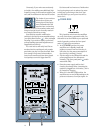
6
OL
PWR
HIGH RESOLUTION
STUDIO MONITOR
ON
OFF
OL
PWR
HIGH RESOLUTION
STUDIO MONITOR
ON
OFF
Figure 2. Horizontal Placement
Additional Tidbits of Wisdom
• When you shut down your equipment, turn
off the HR824 studio monitors first to
prevent thumps and other noises generated
by any upstream equipment from coming
out the speakers. When powering up, turn
on the monitors last.
• Save the shipping box! You may need it
someday, and you don’t want to have to pay
for another one.
• Save your sales receipt in a safe place.
• Also record both HR824 serial numbers in
the space provided on the inside front
cover, along with where and when you
bought them.
Placement
The HR824s were designed to be placed in a
vertical position. If you find it necessary to
place the speakers in a horizontal position (on
their sides), place them so that the woofers are
toward the inside; that is, so the woofers are
closest to each other. This provides the best
low-frequency summing and overall imaging.
AN EXTREMELY IMPORTANT NOTE
ON HR824 BASS RESPONSE AND
YOUR CONTROL ROOM.
Your new HR824s achieve
their best bass response in
a room that’s optimized for
bass reproduction. A lot of
factors can conspire to
thwart the HR824s’ extended low frequency —
including room shape, room volume and
acoustical treatment.
This is not a cop-out or an apology. It’s plain
old physics in action. Luckily we’ve armed you
with some compensating controls which you
can use to optimize the frequency response of
the speakers in your particular room. Consider
the following:
The ACOUSTIC SPACE switch
must be set correctly.
When you put your HR824s in a corner or
up against walls, their bass characteristics
change. Adjust the
ACOUSTIC SPACE
switch setting accordingly to avoid muddy or
exaggerated low frequency response.
Feel free to experiment.
In many respects, every control room is
unique in terms of its acoustics.
Even after you’ve read about how to set the
HR824’s rear panel switches, try other settings
to see if your particular room environment
requires different adjustments.
And, even after you’ve placed your monitors
where you think they’ll sound best, try moving
them around. You might be pleasantly surprised.
Finally, keep an open mind about
improving your room’s acoustics
and bass-handling ability.
Nobody likes to buy a new set of monitor
speakers and then be told that they should
spend extra bucks on bass traps or a remodeling
job. But the simple fact is, “standard” rooms,
i.e. rectangular rooms in conventional business
or residential structures, are rarely if ever
conducive to optimal low bass reproduction
without some modifications.
Luckily, there are plenty of options short of
building a new control room, many of which
are covered in this manual.


















